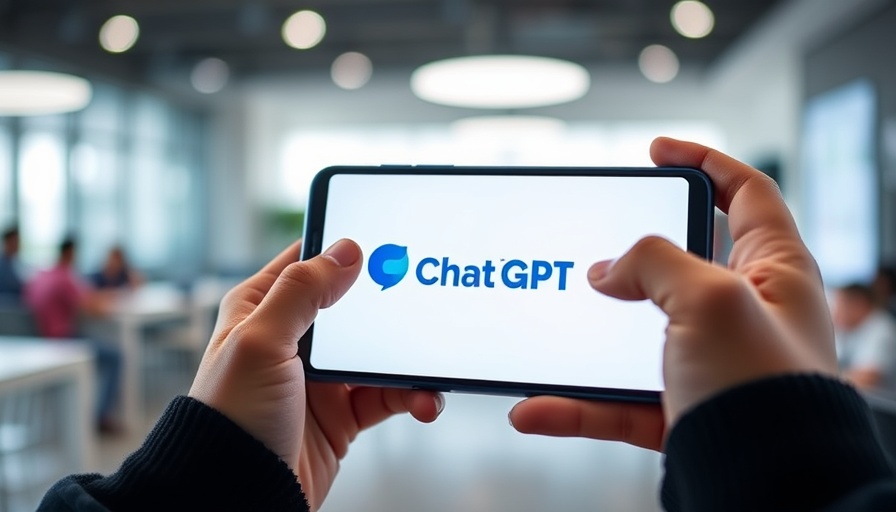
Understanding the Chaos: How ChatGPT Can Help You Regain Control
Feeling overwhelmed by the demands of modern life is a shared experience among many working professionals. From juggling project deadlines to maintaining a work-life balance, it’s easy to feel like all the chaos is spiraling out of control. If you've found yourself in this predicament, the innovative use of artificial intelligence (AI) through ChatGPT could offer the lifeline you need.
Discovering ChatGPT as a Personal Life Strategist
Recent discussions on platforms like Reddit have unveiled prompts that allow ChatGPT to function almost like a personal life coach. One such prompt, suggested by user u/celestialsolace, is gaining traction among users seeking structure in their busy lives. The basic framework involves asking ChatGPT to take on the role of a personal life strategist, urging it to identify key struggles the user faces and suggest practical, actionable tasks.
For anyone looking to manage their time better, the prompt states: “You are my personal life strategist. Your job is to observe my behavior, help me set weekly goals, hold me accountable gently but firmly, and redesign my life systems.” It essentially turns the AI into a supportive guide that checks in with users regularly, allowing for flexible but consistent structure in their daily lives.
Why This Prompt Works: User Experience and Commitment
Productivity hinges on consistency, and while many could write off such AI tools as gimmicks, they have proven value for users willing to engage earnestly. For instance, the author of the referenced article mentioned starting it only recently but was already impressed by ChatGPT's efficiency in breaking down essential tasks.
Acknowledging that this tool thrives on user input, the success of this initiative is deeply rooted in how much data one willingly shares about their routines and aspirations. Keep in mind that it may take repeated interactions over time for users to truly see the fruit of their partnership with ChatGPT.
Expanding the Use Case: Diverse AI Applications
Some savvy users have even begun transferring the frameworks established by ChatGPT into other AI roleplay applications, such as Nectar AI or Janitor AI. These platforms allow for an ongoing 'coach' persona that can remember the user’s routines and progress—essentially keeping the motivational ball rolling.
This kind of long-term relationship with AI isn’t just a passing trend; it may signify a larger cultural shift towards incorporating technology into personal development. As AI continues maturing, our understanding of how it can assist in achieving a balanced life is likely to evolve significantly.
How Can You Utilize ChatGPT in Your Daily Life?
If you are eager to see how this can work within your unique situation, start by crafting your personalized ChatGPT prompt. Think about specific areas of your life where you struggle—be it time management, stress reduction, or enhancing productivity. Tailoring your questions to reflect your actual hurdles will allow the AI to respond more effectively.
For example, consider incorporating structured questions that focus on identifying your peak productivity times, setting tangible goals, and establishing realistic boundaries in your professional life. This awareness of your patterns can be pivotal in taking back control.
Staying Mindful of AI's Limitations
As we embrace this technology, it’s also vital to recognize its limitations. Relying exclusively on AI for emotional or mental health support can be detrimental. Expert professionals should complement AI resources for those seeking wellness guidance. It’s crucial to maintain a healthy balance. This approach can lead to richer insights that are safe and effective.
The Emotional Benefits of Structured Support
Using a resource like ChatGPT provides not just a productivity boost but can also foster a sense of accountability and emotional stability. Knowing someone—or something—is there to guide you can alleviate feelings of loneliness or overwhelm. It creates a supportive environment where you can thrive while navigating the complexities of work and home life.
Take the Next Step: Embrace Change with AI
Change is never easy, but integrating AI into your daily routine could be a significant step towards reclaiming your time and enhancing your productivity. With patience and commitment, this approach could foster the personal growth you need to combat the chaos of modern life.
Considering how many professionals are already feeling the weight of their responsibilities, trying out AI as a supportive ally might just be the answer they are looking for. Why not give it a shot and see how it transforms your daily structure?
 Add Row
Add Row  Add
Add 




Write A Comment